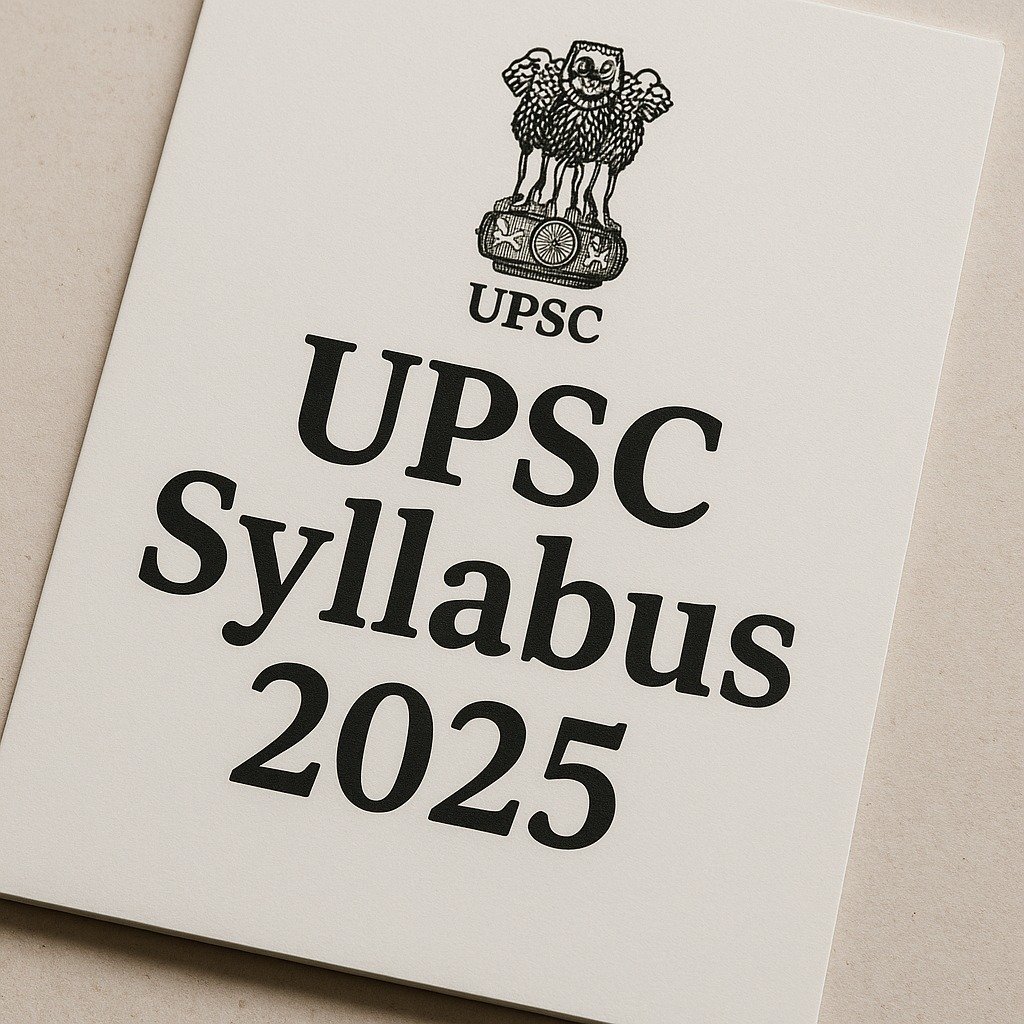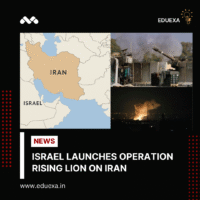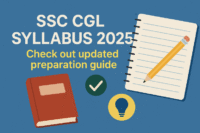Preparing for UPSC CSE in 2025? The first thing you are searching for is the updated UPSC syllabus in 2025. For the beginners, let me tell you, having a clear understanding of the syllabus is the first step towards success in the UPSC CSE exam. Be it a first time aspirant or an experienced repeater, every candidate has to stay updated with the latest guidelines and syllabus of the exam. This blog will cover the complete syllabus of for upsc including, upsc syllabus for prelims, upsc syllabus for mains along with providing cse upsc syllabus pdf in a downloadable format.
Overview of the UPSC CSE exam
Union Public Service Commission (UPSC) conducts Civil Services Exams for recruitment under different government offices like IAS, IPS, IFS and other positions. These exams are conducted in 3 phases:- Prelims, Mains and the Interview.
STAGE 1: Prelims: This stage consists of 2 objective type papers conducted for a duration of 2 hours each. The marks of this round are not calculated for final rankings.
STAGE 2: Mains: It is a written exam where 9 papers are taken including 2 qualifying exams and the rest 7 as ranking.
STAGE 3: Interview: This is the final stage of UPSC CSE exam and the maximum marks for interview is 275.
“Read the complete detail about the UPSC exam“
UPSC Syllabus for prelims

The prelims exam consists of 2 papers- Paper I and II. Paper I is a general studies paper which tests general knowledge of the students over subjects like history, geography, economics, polity, art, culture and science. This paper is cut off based and hence the results depend on the marks obtained by other students. Paper II is a CSAT paper which tests the common aptitude of the candidates is of qualifying nature i.e. you just need to secure 67 marks to pass this exam.
| UPSC CSE Syllabus for Prelims | |
| Paper I- General Studies Paper | ● Current events of national and international importance ● History of India and Indian National Movement ● Indian and World Geography- Physical, Social, Economic geography of India and the World. ● Indian Polity and Governance- Constitution, Political System, Panchayati Raj, Public Policy, Rights Issues ● Economic and Social Development- Sustainable Development, Poverty, Inclusion, Demographics, Social Sector Initiatives, etc. ● General issues on Environmental Ecology, Biodiversity and Climate Change- that do not require subject specialisation ● General Science |
| Paper II- Civil Service Aptitude Test (CSAT) | ● Comprehension ● Interpersonal skills including communication skills; ● Logical reasoning and analytical ability ● Decision-making and problem solving ● General mental ability ● Basic numeracy(numbers and their relations, orders of magnitude, etc.) (Class X level), ● Data interpretation (charts, graphs, tables, data sufficiency etc.- Class X level) |
“Click here to download the upsc syllabus pdf for prelims”
UPSC Syllabus for mains
The Civil Services Main written examination consists of nine papers, two of which are qualifying and the other seven of which are ranking. Each paper lasts for three hours. Qualifying papers are ordered according to marks, and the Commission selects a few candidates for an interview or a personality test.
All of the questions in the UPSC Mains exam are of the descriptive answer variety. It’s a gruelling and time-consuming phase, and the total marks in UPSC mains directly determine your final grades. Consequently, the UPSC exam results for the mains phase play a critical role in determining the final merit list.

| PAPERS | SYLLABUS |
| PAPER 1 ESSAY | In this paper, candidates have to write 2 essays on any given topic. The topic would be open-ended as there is no prescribed syllabus for essay paper. |
| PAPER 2 GENERAL STUDIES I | ● Indian culture will cover the salient aspects of Art Forms, literature and Architecture from ancient to modern times. ● Modern Indian history from about the middle of the eighteenth century until the present significant events, personalities, issues. ● The Freedom Struggle —its various stages and important contributors/contributions from different parts of the country. ● Post-independence consolidation and reorganisation within the country. ● History of the world will include events from the 18th century such as industrial revolution, world wars, redrawal of national boundaries, colonisation, decolonization, political philosophies like communism, capitalism, socialism etc.— their forms and effect on the society. ● Salient features of Indian Society, Diversity of India. ● Role of women and women’s organisation, population and associated issues, poverty and developmental issues, urbanisation, their problems and their remedies. ● Effects of globalization on Indian society. ● Social empowerment, communalism, regionalism & secularism. ● Salient features of the world’s physical geography. ● Distribution of key natural resources across the world (including South Asia and the Indian sub-continent); factors responsible for the location of primary, secondary, and tertiary sector industries in various parts of the world (including India). ● Important Geophysical phenomena such as earthquakes, Tsunami, Volcanic activity, cyclones. etc., geographical features and their location-changes in critical geographical features (including water-bodies and ice-caps) and in flora and fauna and the effects of such changes. |
| PAPER 3 GENERAL STUDIES II | ● Constitution of India —historical underpinnings, evolution, features, amendments, significant provisions and basic structure. ● Functions and responsibilities of the Union and the States, issues and challenges pertaining to the federal structure, devolution of powers and finances up to local levels and challenges therein. ● Separation of powers between various organs dispute redressal mechanisms and institutions. ● Comparison of the Indian constitutional scheme with that of other countries. ● Parliament and State legislatures—structure, functioning, conduct of business, powers & privileges and issues arising out of these. ● Structure, organisation and functioning of the Executive and the Judiciary—Ministries and Departments of the Government; pressure groups and formal/informal associations and their role in the Polity. ● Salient features of the Representation of People’s Act. ● Appointment to various Constitutional posts, powers, functions and responsibilities of various Constitutional Bodies. ● Statutory, regulatory and various quasi-judicial bodies. ● Government policies and interventions for development in various sectors and issues arising out of their design and implementation. ● Development processes and the development industry —the role of NGOs, SHGs, various groups and associations, donors, charities, institutional and other stakeholders. ● Welfare schemes for vulnerable sections of the population by the Centre and States and the performance of these schemes; mechanisms, laws, institutions and Bodies constituted for the protection and betterment of these vulnerable sections. ● Issues relating to development and management of Social Sector/Services relating to Health, Education, Human Resources. ● Issues relating to poverty and hunger. ● Important aspects of governance, transparency and accountability, e-governance applications, models, successes, limitations, and potential; citizens charters, transparency & accountability and institutional and other measures. ● Role of civil services in a democracy. ● India and its neighbourhood- relations. ● Bilateral, regional and global groupings and agreements involving India and/or affecting India’s interests. ● Effect of policies and politics of developed and developing countries on India’s interests, Indian diaspora. ● Important International institutions, agencies and fora- their structure, mandate. |
| PAPER 4 GENERAL STUDIES III | ● Indian Economy and issues relating to planning, mobilisation, of resources, growth, development and employment. ● Inclusive growth and issues arising from it. ● Government Budgeting. ● Major crops-cropping patterns in various parts of the country,– different types of irrigation and irrigation systems storage, transport and marketing of agricultural produce and issues and related constraints; e-technology in the aid of farmers. ● Issues related to direct and indirect farm subsidies and minimum support prices; Public Distribution System- objectives, functioning, limitations, revamping; issues of buffer stocks and food security; Technology missions; economics of animal-rearing. ● Food processing and related industries in India- scope and significance, location, upstream and downstream requirements, supply chain management. ● Land reforms in India. ● Effects of liberalisation on the economy, changes in industrial policy and their effects on industrial growth. ● Infrastructure: Energy, Ports, Roads, Airports, Railways etc. ● Investment models. ● Science and Technology- developments and their applications and effects in everyday life. ● Achievements of Indians in science & technology; indigenization of technology and developing new technology. ● Awareness in the fields of IT, Space, Computers, robotics, nano-technology, bio-technology and issues relating to intellectual property rights. ● Conservation, environmental pollution and degradation, environmental impact assessment. ● Disaster and disaster management. ● Linkages between development and spread of extremism. ● Role of external state and non-state actors in creating challenges to internal security. ● Challenges to internal security through communication networks, role of media and social networking sites in internal security challenges, basics of cyber security; money-laundering and its prevention. ● Security challenges and their management in border areas– linkages of organized crime with terrorism. ● Various Security forces and agencies and their mandate. |
| PAPER 5 GENERAL STUDIES IV | ● Ethics and Human Interface: Essence, determinants and consequences of Ethics in-human actions; dimensions of ethics; ethics– in private and public relationships. Human Values lessons from the lives and teachings of great leaders, reformers and administrators; role of family society and educational institutions in inculcating values. ● Attitude: content, structure, function; its influence and relation with thought and behaviour; moral and political attitudes; social influence and persuasion. ● Aptitude and foundational values for Civil Service, integrity, impartiality and non-partisanship, objectivity, dedication to public service, empathy, tolerance and compassion towards the weaker sections. ● Emotional intelligence-concepts, and their utilities and application in administration and governance. ● Contributions of moral thinkers and philosophers from India and the world. ● Public/Civil service values and Ethics in Public administration: Status and problems; ethical concerns and dilemmas in government and private institutions; laws, rules, regulations and conscience as sources of ethical guidance; accountability and ethical governance; strengthening of ethical and moral values in governance; ethical issues in international relations and funding; corporate governance. ● Probity in Governance: Concept of public service; Philosophical basis of governance and probity; Information sharing and transparency in government, Right to Information, Codes of Ethics, Codes of Conduct, Citizen’s Charters, Work culture, Quality of service delivery, Utilisation of public funds, challenges of corruption. ● Case Studies on the above issues |
| PAPER 6- Optional paper 1 | Two papers are conducted for optional subjects. You choose 1 subject from song the following discourses:- Agriculture Animal Husbandry and Veterinary Science Anthropology Botany Chemistry Civil Engineering Commerce and Accountancy Economics Electrical Engineering Geography Geology History Law Management Mathematics Mechanical Engineering Medical Science Philosophy Physics Political Science and International Relations Psychology Public Administration Sociology Statistics Zoology Literature of any one of the following languages: Assamese, Bengali, Bodo, Dogri, Gujarati, Hindi, Kannada, Kashmiri, Konkani, Maithili, Malayalam, Manipuri, Marathi, Nepali, Oriya, Punjabi, Sanskrit, Santali, Sindhi, Tamil, Telugu, Urdu, and English. |
| PAPER 7- Optional paper 2 |
Click here to download the UPSC syllabus pdf for Mains
Conclusion
Understanding the latest upsc syllabus and exam guidelines is an important step towards your success. Syllabus helps the students to analyze the topics they have to study so that they do not miss out on any topic. Prepare well for the exam and work hard to crack the exam in one go.
All the best aspirants! Stay focussed and stay updated!
FAQs
- Can I crack UPSC in 1 year?
Yes, with good understanding of upsc syllabus, strong will power, consistent efforts and self-belief can help you crack UPSC in 1 year.
- Is 60% required for Upsc?
There is no minimum percentage requirement for UPSC. You must have a minimum qualification of bachelors degree in order to be eligible for UPSC exams.
- Does Upsc revise its syllabus every year?
No, it does not always revise the syllabus but it is always recommended to check for the updated syllabus and guidelines.
- Does 12th marks matter in UPSC?
No, 12th marks does not matter in upsc. All the candidates who have cleared their graduation exams are equally eligible for UPSC exam.



